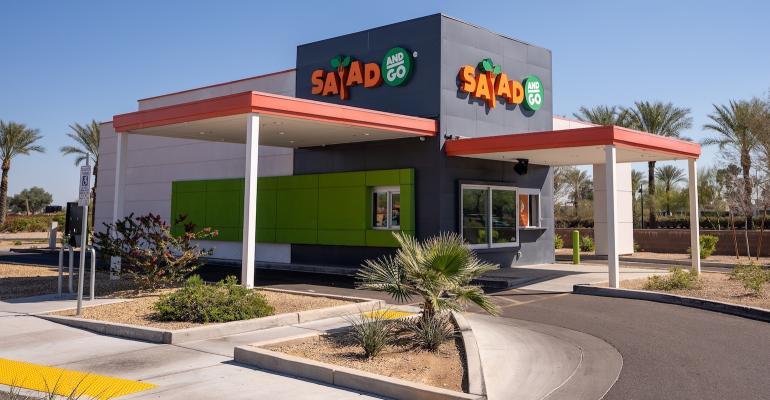Charlie Morrison led Wingstop through a meteoric growth spurt, solidly positioning the brand as a “category of one” that outpaced most of its peers in sales and traffic, including and especially through the pandemic. So when he left in 2022 for the same role at a tiny and relatively new drive-thru concept called Salad and Go, it was a bit of a surprise.
Morrison, however, sat on the board of Salad and Go, founded in 2013, and was “enamored” with the brand and its mission. To him, the move was a no-brainer.
“We are revolutionizing the idea of the drive-thru and we do it by providing consumers with a salad that is served in a 48-ounce bowl and usually under three or four minutes at a price that’s under $7, including protein,” he said during a presentation at the ICR Conference this week in Orlando.
The “revolution” part comes from that price point; making healthier food more affordable and accessible is the company’s north star. The average cost of a salad is much higher, Morrison said, while most aren’t easily available via a drive-thru-only location. According to Technomic Ignite data, the average price of an entrée salad is north of $11.
The company is able to crack the cost code because it was designed around the idea of “rebuilding the supply chain and fixing what is broken,” as Morrison explained. Salad and Go has a central kitchen, or commissary, where all of the produce is washed, cut and prepared for distribution. The dressings and concentrates for drinks are also made in the central kitchen.
“Doing that helps us take out a ton of the labor that is in the back of the house of a typical restaurant. Now, it’s more capital intensive this way, but if you’re dealing with labor challenges … And, by taking steps out of the supply chain, we’ve been able to take that cost and turn it back into an affordable price point for the consumer,” Morrison said. “We eliminated this conflict that exists between affordability and accessibility with a distribution model that works.”
The model also delivers a higher margin, he added, and allows the company to pay team members $15 an hour.
Salad and Go now has two such central kitchens – in its hometown of Phoenix and now in Dallas – and each can support at least 400 stores. There are currently just 130 Salad and Go locations, but Morrison believes the concept can – and should – get much, much bigger than that.
“Each time we build (a central kitchen), a ton of capacity is unlocked for the future. Job one is get the word out to grow the brand. Secondly, we want to make sure we’re executing exceptionally well,” Morrison said. “Barring any other challenges, the potential is there for thousands of locations.”
Indeed, last year the company built about a store a week and Morrison expects that pace to continue. This year will include entry into California, Kansas, and Arkansas, while the company also has its sights on Southeast markets, including Atlanta, in 2025 and beyond. Aside from demand, driving this swift growth is the model. Salad and Go locations are only about 750 square feet, which enables the company to find “unique pockets of real estate.” The double drive-thru includes a dedicated lane for mobile pickup, which now makes up about 20% of the mix.
“We’re trying to make access the key,” Morrison said.
What customers are able to access are eight featured salads curated by a Michelin Star-trained chef. There is also a lineup of breakfast burritos and bowls, coffee, and cold brew. Morrison said the company’s breakfast sales are around 20%, driven in large part by customers who come in for a morning pick-me-up and who also grab a salad for lunch while they’re there. Protein options for the salads include chicken or tofu, as well as steak as an add-on. There are no plans to trip up the company’s operational simplicity by expanding the menu.
“I’m a big believer in keeping things focused on what you do well,” Morrison said.
What the company is expanding, however, is its digital infrastructure and its brand awareness, putting pieces into place throughout the past 18 months to scale. Those pieces include a new point-of-sale system, customer database, CFO and CMO. The customer database, by the way, includes over 4 million unique users, which Morrison notes is “crazy for 130 stores.”
“The brand is growing fast and now is the time to tell the world and … focus on building relationships with the customer,” he said. “I think the mission is well understood. It’s what people want – affordability and healthy food. Those two just don’t go hand in hand typically. The faster we can grow, the better.”
Contact Alicia Kelso at [email protected]





